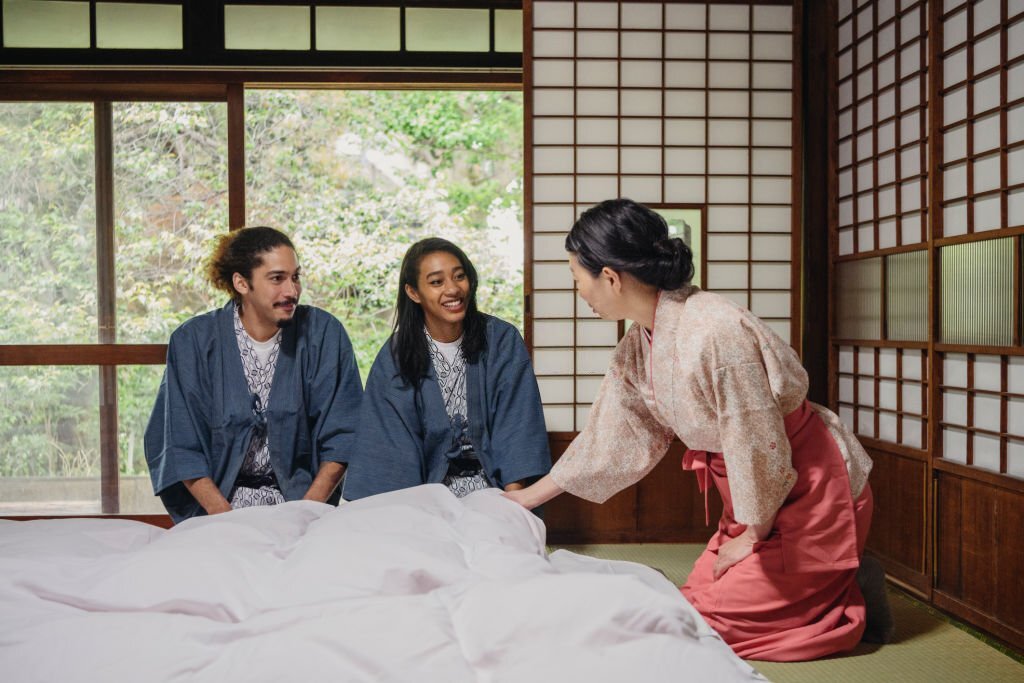Imagine waking up in the morning, stepping out of bed, and finding yourself on a soft, straw mat. This isn’t some fantastical dream; it’s the reality for many Japanese homes. Sleep on the floor, or more precisely, on a futon laid out on tatami mats, is a common practice in Japan that goes beyond simple practicality. It’s deeply intertwined with cultural values, traditional design, and even health benefits.

Image: mykoreanaddiction.com
For those unfamiliar with Japanese culture, the idea of sleeping on the floor might seem strange, even uncomfortable. But behind this seemingly unconventional practice lies a rich history and a unique way of life. This article explores the reasons why people in Japan sleep on the floor, delving into the cultural and practical aspects, examining the health benefits, and uncovering the changing trends in modern Japan.
A History of Floor Sleep
From Ancient Times to the Modern Era
The practice of sleeping on the floor in Japan, known as “yokyo,” has roots dating back to ancient times. In the pre-modern era, with simple living conditions, most people slept on straw mats laid directly upon earthen floors. This minimalist approach reflected the practicality of living, with minimal furniture and a focus on the natural materials of tatami, a woven mat made from rice straw. Tatami, in fact, became a central element of traditional Japanese homes, offering a comfortable and breathable surface for both day and night.
As Japan modernized in the early 20th century, Western influences led to the adoption of beds, especially in urban areas. However, traditional floor sleeping persisted, particularly in rural areas and among those who prized the comfort and simplicity of tatami. The humble futon, a lightweight and portable mattress, further facilitated the tradition.
The Rise and Fall of the Western Bed
The rapid economic growth and urbanization of post-World War II Japan brought about a shift in living standards. Western furniture, including beds, became more prevalent. This marked a period of intense societal change, with many young Japanese adopting westernized lifestyles.
However, the allure of traditional floor sleeping remained. Futons, with their ease of storage and versatility for both sleeping and lounging, remained a popular choice. The simplicity and adaptability of this practice resonated with the fast-paced urban lifestyle, where space was a premium. Furthermore, tatami, with its natural fragrance and breathable properties, offered a refreshing and calming environment.

Image: viewfloor.co
Why Sleep on the Floor in Japan?
Cultural Considerations: Simplicity and Harmony
The practice of floor sleeping, beyond its practical benefits, holds a deep cultural significance. It reflects the Japanese values of simplicity, minimalism, and harmony with nature. Living close to the ground, as it were, encourages a sense of grounding and connection to the natural world.
Imagine entering a traditional Japanese home. The absence of bulky furniture creates a sense of openness and spaciousness. The tatami surface, with its soft texture and pleasant aroma, adds a touch of warmth and serenity. This focus on the essential elements of living, devoid of clutter and extravagance, embodies the Japanese aesthetic of wabi-sabi, recognizing beauty in simplicity and imperfection.
Practicality and Versatility
Practical considerations also play a significant role. The compact nature of the futon allows for easy storage during the day, freeing up floor space for various activities. This flexibility is particularly valuable in smaller homes, common in urban areas. The portability of the futon also makes it ideal for accommodating guests or for use in multi-functional spaces.
Beyond storage, futons are a flexible seating option. Imagine gathering with friends or family. Instead of rigid chairs, you can sit comfortably on the futon laid out on the tatami, creating an intimate and relaxed atmosphere. This flexibility and adaptability of the futon system seamlessly blends practicality with a sense of coziness and comfort.
Health Considerations: The Potential Benefits
Sleeping on the floor, particularly on a traditional tatami surface, can offer potential health benefits. The breathable nature of tatami allows for air circulation, reducing humidity and promoting a comfortable sleep environment. The natural fibers of tatami are also hypoallergenic, minimizing exposure to irritants and allergens frequently found in bedding materials.
Furthermore, sleeping on the floor encourages better posture. The absence of a raised bed forces the body to maintain a more natural alignment, which can potentially promote spinal health and alleviate back pain.
Contemporary Trends: The Changing Landscape
While the tradition of floor sleeping remains strong, especially in older generations, the modern Japanese generation embraces a more diverse range of sleeping options. A growing number of young Japanese opt for Western beds, as they prioritize comfort and personal preference. This diversification reflects the evolving lifestyle and influences of global culture.
However, the allure of traditional floor sleeping persists. For many, the practicality, health benefits, and cultural significance of sleeping on futons continue to hold appeal. Despite the changing trends, the practice of floor sleeping remains deeply ingrained in Japanese culture, symbolizing a lifestyle that values simplicity, harmony, and connection to the natural world.
Do People Sleep On The Floor In Japan
Conclusion: A Tradition that Evolves
The practice of sleeping on the floor in Japan, rooted in tradition and practicality, continues to evolve in modern society. While Western beds gain popularity, the charm of futons and tatami holds a firm place in Japanese culture, reflecting a deep appreciation for simplicity, health, and a connection to nature. Exploring the reasons behind this unique practice sheds light on the complexities of cultural customs, how they shape lifestyle choices, and how tradition adapts to the changing tides of time. Whether you choose a Western bed or a traditional futon, understanding the cultural significance and potential benefits of floor sleeping brings a richer appreciation for the diverse ways people around the world live and sleep.






